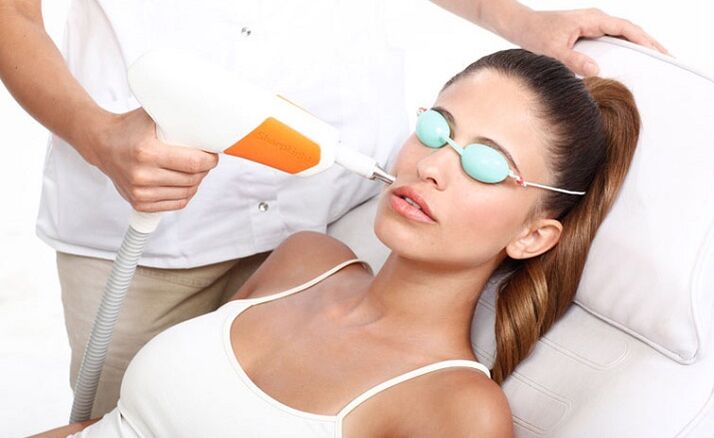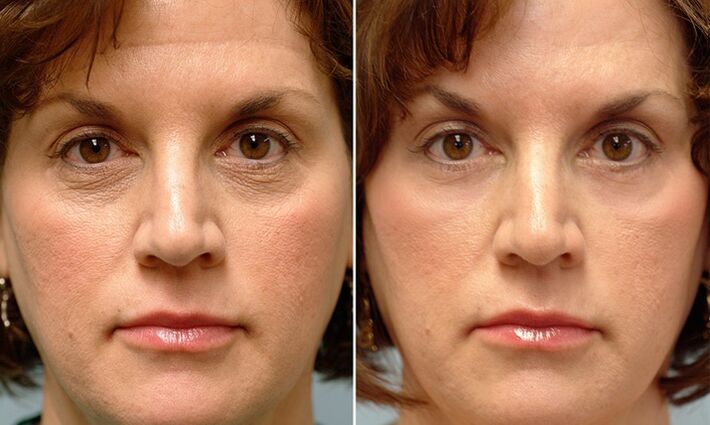From the time of Cleopatra to the present day, there is no representative of the fair sex who does not want to prolong the youth and beauty of his skin. Modern medical science continues to amaze with its innovations in the field of cosmetology, which offers a variety of anti-aging operations and procedures.
Methods that allow you to get rid of external signs of aging without resorting to a scalpel or Botox injections are especially popular. Fractional laser rejuvenation is currently the fastest and most reliable way to combat skin aging.

What is a fractional laser and how it "rejuvenates"
When the laser hits the skin, a deep burn occurs. Active healing (regeneration) processes begin, providing the desired cosmetic effect. This procedure is known in cosmetology as laser skin surface.
If the same laser is divided into many micro-beams, then a fractional laser beam is obtained. Such a beam will no longer act as a whole point on the skin, but as an intermediate microgrid. After fractional laser thermolysis, the burns are in the form of a large number of micro-dots between the non-woven skin. This procedure significantly reduces trauma (and pain) and allows the skin to recover faster.
After being exposed to the laser, healthy skin cells begin to divide actively, forming collagen and elastin, which provide elasticity and a youthful appearance to the skin.
Types of fractional photothermolysis
Ablative
Under the influence of laser radiation, water evaporates from the tissues and an "open" microscopic wound is formed in which the damaged (burned) cells are located.
An open lifting effect occurs during healing, but there is a danger of penetrating the deeper layers of the skin.
Non-ablative
Radiation is used to keep the epidermis intact, so there is no evaporation from the tissues and the formation of "open" wounds. The burn occurs under the epidermis and heals, so there is no risk of infection, but the rejuvenating effect of this procedure is less noticeable.
The cosmetologist chooses the method of rejuvenation individually, depending on the condition and type of skin.
Effects and Benefits of Fractional Laser Thermolysis
The main difference between the technique and all other procedures is the optimal balance between safety and efficiency.
Main advantages:
- ability to affect any part of the body (including the décolleté, neck, eyelids);
- broad indicators;
- physiology (the area of damage is only 20% of the total area treated with laser);
- short healing time (2-7 days);
- method of anesthesia - application;
- possibility of use in people with dark skin (because it does not cause hyperpigmentation);
- duration of the result (from one to several years).
The downside is that there is a lack of information on all aspects of the effects of fractional lasers, as the technology itself has only recently emerged.
Tips for fractional rejuvenation:
- wrinkles (at any depth and place);
- decrease in the elastic properties of the skin;
- enlarged pores;
- pigmentation;
- acne;
- spider veins;
- scars (postoperative, post-acne residue);
- Stretch marks (striae), including the skin of the mammary glands.
Features of fractional laser thermolysis
A few days before the photothermolysis procedure, the cosmetologist may prescribe antibacterial or antiviral drugs in prophylactic doses (if indicated).
On the day of rejuvenation, physical activity, smoking and alcohol consumption should be completely excluded.
Before the procedure, the skin is thoroughly cleansed and treated with a special anesthetic cream. In some cases, anesthesia is not required at all.
The effect of the laser is felt as "tingling" or "tingling". The duration of the procedure (from a few minutes to an hour) and their number are selected individually. After the laser treatment, a soothing nourishing cream is applied to the skin.
Followed skin care:
- Moisturize the skin with a special cream 2-3 times a day (for 2 weeks);
- protect the skin from ultraviolet radiation for 2 months (do not visit the solarium, use sunscreen with at least 30 protection factors);
- do not use peels and scrubs (within 2 weeks);
- do not use cosmetics containing salicylic acid and retinol (within 2 weeks);
- do not wear compression underwear for several days (if fractional photothermolysis is performed on the body);
- limit (exclude) smoking and alcohol throughout the treatment (reduces the regenerative functions of the skin).

On average, the rehabilitation period lasts up to 3 days after non-ablative fractional laser thermolysis and up to 7 days after ablative thermolysis.
The skin changes after the procedure
After 1-3 days of strong laser exposure, redness, discomfort and slight swelling of the skin may continue. If this condition is subjectively poorly tolerated, the use of painkillers and skin cooling is allowed.

After a few days, a bronze skin tone (darkening effect) that lasts up to 2 weeks and disappears on its own may appear. Dryness and peeling of the skin is noted within 5-7 days after fractional rejuvenation.
Undesirable results and contraindications for photothermolysis
Following a procedure, the following complications are possible due to improper skin care, non-compliance with recommendations, or technical errors during laser treatment:
- Redness of the skin lasting more than 3 days;
- edema at the site of exposure, lasting more than 2 days;
- exacerbation of herpes infection (if previously in the treatment area);
- infection (appearance of streptoderma);
- erosion, burns in the affected area;
- precise bleeding;
- hyperpigmentation.
To avoid unwanted results, the fractional laser rejuvenation procedure is performed after examination and possible contraindications are excluded.
Absolute contraindications:
- pregnancy and breastfeeding;
- tendency to form keloid scars;
- acute infectious process (including herpes);
- oncology pathology;
- condition after radiation, chemotherapy;
- epilepsy;
- significant disorders of the immune system;
- taking drugs containing retinoids;
- psoriasis during inflammation (atopic dermatitis).
Relative:
- renal pathology;
- diabetes;
- inflammation at the site of exposure;
- the patient's unwillingness to follow the cosmetologist's recommendations;
- mental illness;
- allergy to anesthesia;
- autoimmune diseases;
- fresh tanning (visit to the solarium during the last month);
- final rejuvenation procedures (affects the deeper layers of the skin - within the last three months, superficial - within 10 days).
Fractional laser rejuvenation and images of patients from the "before" and "after" series generally undermine the effectiveness and low trauma of this method to preserve youth.

Don't forget!The procedure can only be performed by trained professionals (surgeons or dermatovenerologists) who are trained and licensed to work with laser devices. The skill of a doctor is the key to your beauty!














































































